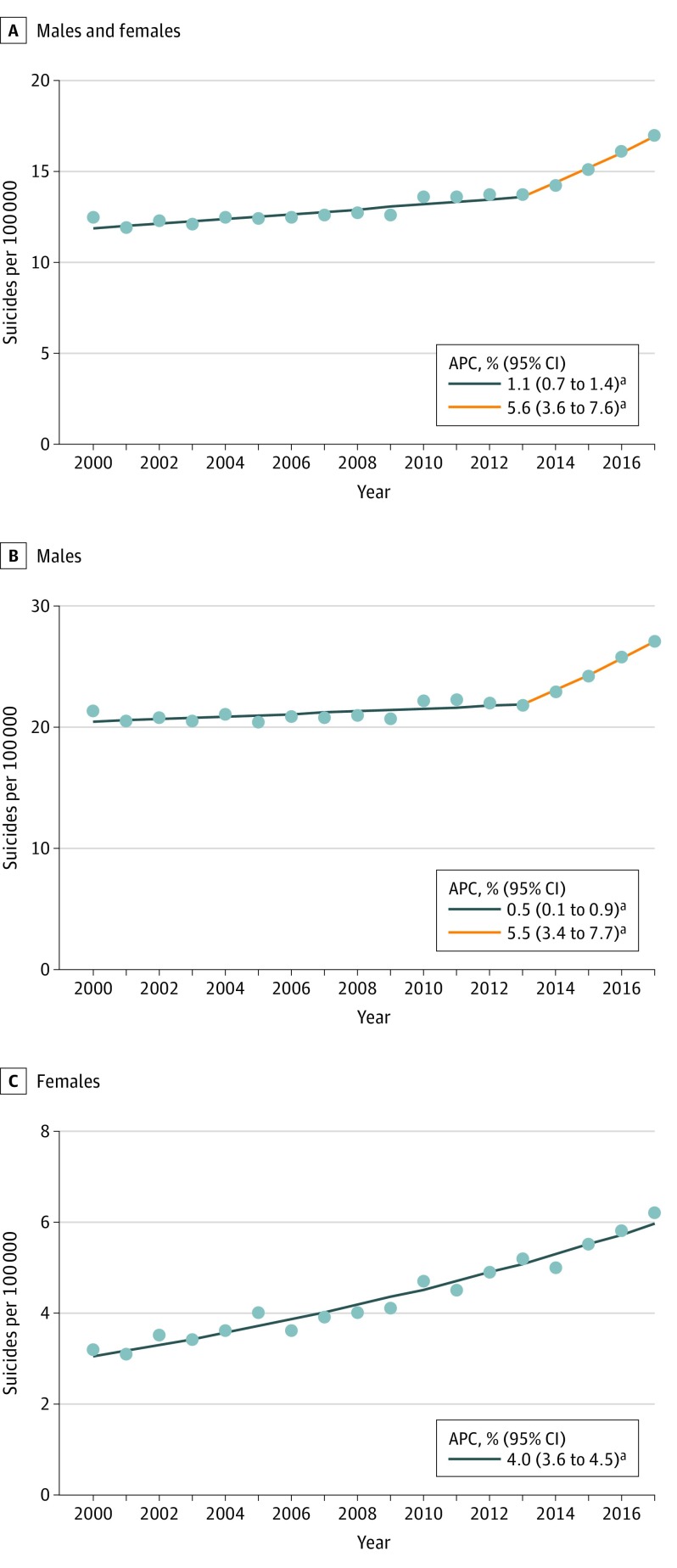Abstract
This study uses Centers for Disease Control and Prevention (CDC) data to characterize trends in suicide rates among adolescents and young adults aged 15 to 24 years in the United States and to determine if the increase in suicide rates observed in years 2000-2016 is continuing.
The Centers for Disease Control and Prevention (CDC) reported a 30% increase in suicides in the United States from 2000 to 2016, with rates increasing in all age groups.1 However, adolescents are of particular concern, with increases in social media use, anxiety, depression, and self-inflicted injuries.2 The CDC reported suicide rates in youths aged 15 to 24 years, but a more detailed analysis of the trends in this age group is needed, as well as examination of the most recent available data to determine if the increase in suicide rates is continuing.
Methods
We searched the CDC Underlying Cause of Death database, a national data set based on death certificates and population estimates from the US Census Bureau. This data set is publicly available, and the Harvard Medical School institutional review board determined that approval and informed consent were not needed. We identified suicide based on International Statistical Classification of Diseases and Related Health Problems, Tenth Revision codes (X60-X84) from 2000 to 2017.3 We examined ages 15 to 19 years and 20 to 24 years for males and females in aggregate and separately, calculating time points at which trends changed, expressed as annual percentage change (APC). The JoinPoint version 4.7 (National Cancer Institute) regression program was used for all analyses, and the threshold for significance was P < .05 (2-tailed).
Results
In 2017, 6241 suicides occurred in individuals aged 15 to 24 years, of which 5016 were male and 1225 were female. At ages 15 to 19 years, the rate of suicides was 11.8 per 100 000 (17.9 per 100 000 in males and 5.4 per 100 000 in females).
In adolescents aged 15 to 19 years, the suicide rate in 2000 was 8 per 100 000, with no change in trend from 2000 to 2007 (APC, −1.7% [95% CI, −3.6% to 0.3%]), an increasing trend from 2007 to 2014 (APC, 3.1% [95% CI, 0.5%-5.7%]), followed by a larger increasing trend from 2014 to 2017 (APC, 10.0% [95% CI, 4.3%-16.0%]) (Figure 1A). In males, there was a decreasing trend from 2000 to 2007 (APC, −2.2% [95% CI, −3.6% to −0.7%]), an increasing trend from 2007 to 2015 (APC, 2.6% [95% CI, 1.2%-4.0%]), and an increasing trend from 2015 to 2017 (APC, 14.2% [95% CI, 2.9%-26.7%]) (Figure 1B). In females, there was no trend from 2000 to 2010 (APC, 1.8% [95% CI, −0.9% to 4.6%]) and an increasing trend from 2010 to 2017 (APC, 8.2% [95% CI, 5.0%-11.5%]) (Figure 1C).
Figure 1. Trends in Suicide Death Rates at Ages 15-19 Years.
Circles indicate observed data points. APC indicates annual percentage change.
aSignificant at P < .05.
In young adults aged 20 to 24 years, the suicide rate for males and females combined in 2017 was 17 per 100 000; in males, 27.1 per 100 000; and in females, 6.2 per 100 000. The rate in 2000 was 12.5 per 100 000, with an increasing trend from 2000 to 2013 of 1.1% APC (95% CI, 0.7%-1.4%) and from 2013 to 2017 of 5.6% APC (95% CI, 3.6%-7.6%) (Figure 2A). In males, there was an increasing trend in APC from 2000 to 2013 of 0.5% (95% CI, 0.1%-0.9%), followed by a larger increasing trend from 2013 to 2017 of 5.5% (95% CI, 3.4%-7.7%) (Figure 2B). In females, there was an increasing trend in APC from 2000 to 2017 of 4.0% (95% CI, 3.6%-4.5%) (Figure 2C).
Figure 2. Trends in Suicide Death Rates at Ages 20-24 Years.
Circles indicate observed data points. APC indicates annual percentage change.
aSignificant at P < .05.
Discussion
The suicide rate at ages 15 to 19 years and 20 to 24 years increased in 2017 to its highest point since 2000, with a recent increase especially in males and in ages 15 to 19 years. A limitation of the study is that the cause of death in the death certificates could occasionally be inaccurate; for example, if a suicide using opioids was mistaken for an accidental overdose. The observed increase in suicide may reflect more accurate reporting, possibly due to coroners and families being more willing to label the death as suicide, or changes in the use of opioids or incidence of depression.4,5 Future studies should examine possible contributing factors and attempt to develop prevention measures by understanding the causes for the decrease in suicides found in the late 1990s.6
Section Editor: Jody W. Zylke, MD, Deputy Editor.
References
- 1.Hedegaard H, Curtin SC, Warner M. Suicide rates in the United States continue to increase. NCHS Data Brief. 2018;(309):1-8. [PubMed] [Google Scholar]
- 2.Mercado MC, Holland K, Leemis RW, Stone DM, Wang J. Trends in emergency department visits for nonfatal self-inflicted injuries among youth aged 10 to 24 years in the United States, 2001-2015. JAMA. 2017;318(19):1931-1933. doi: 10.1001/jama.2017.13317 [DOI] [PMC free article] [PubMed] [Google Scholar]
- 3.Centers for Disease Control and Prevention National Center for Health Statistics CDC WONDER: about underlying cause of death, 1999-2017. https://wonder.cdc.gov/ucd-icd10.html. Published December 2018. Accessed March 1, 2019.
- 4.Stone DM, Simon TR, Fowler KA, et al. Vital signs: trends in state suicide rates—United States, 1999-2016 and circumstances contributing to suicide—27 states, 2015. MMWR Morb Mortal Wkly Rep. 2018;67(22):617-624. doi: 10.15585/mmwr.mm6722a1 [DOI] [PMC free article] [PubMed] [Google Scholar]
- 5.Canner JK, Giuliano K, Selvarajah S, Hammond ER, Schneider EB. Emergency department visits for attempted suicide and self harm in the USA: 2006-2013. Epidemiol Psychiatr Sci. 2018;27(1):94-102. doi: 10.1017/S2045796016000871 [DOI] [PMC free article] [PubMed] [Google Scholar]
- 6.McKeown RE, Cuffe SP, Schulz RM. US suicide rates by age group, 1970-2002: an examination of recent trends. Am J Public Health. 2006;96(10):1744-1751. doi: 10.2105/AJPH.2005.066951 [DOI] [PMC free article] [PubMed] [Google Scholar]




